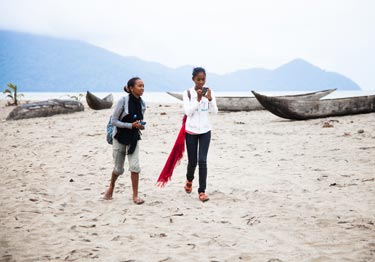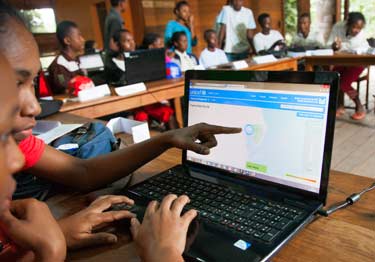Emedianna Zafisoa, 15, is in year 10 at the Collège d’Enseignement Général (CEG) in Maroantsetra, a district in north-eastern Madagascar. Firmly committed to environmental conservation, she is indignant about the trash that piles up in her town, a popular tourist destination because of its beautiful scenery and wildlife.
“People don’t stop throwing their garbage everywhere, and the smells are intolerable,” she confides glumly.
Since 2013, when she joined a UNICEF-supported programme called Connecting Classrooms, Communities and Youth for Biodiversity Conservation (CCCYBC), Emedianna has shown her commitment to protecting the environment.
Creating community awareness
CCCYBC was launched in Madagascar in 2011, based on the Let Us Learn initiative, a collaboration between UNICEF and private donors to provide learning opportunities for the most marginalized children.
As budding young journalists, Emedianna and other participants in the programme have learned reporting skills, and they publish articles on the web about environmental issues in their town. Emedianna is not shy about the satisfaction she gets from sharing her stories with other young people around the world.
Emedianna has participated in other awareness-raising activities, as well, such as ‘Operation Zero Plastic’, which taught people to recycle plastic bags by making baskets and hats.
Digital mapping
It all started when 20 students from the CEG school in Maroantsetra, including Emedianna, were introduced to the Voices of Youth Maps programme, which has been rolled out in three Malagasy towns: Maroantsetra, Toamasina and Ranomafana.
The initiative uses smartphone technology to create an interactive digital map, which enables young people to document issues in the community that they see as important, such as environmental conservation or gender equality. Using a mobilie application, photographs can be uploaded onto the map, which becomes the medium for young people to express themselves by sharing their stories and photographs and advocating for change.
“We took photos of the trash that was piling up next to the Antseranampotsy market, and it was uploaded to a digital map,” says Emedianna. “Soon we’ll be able to approach the authorities and local community with advocacy on this case, as well as all the others.”
While waiting for local authorities and the community to follow up and take action, Emedianna remains hopeful. Her dream is someday to work for UNICEF so that she can become a leader bringing change to her country.
By Abela Ralaivita


